To celebrate James Bond’s 50th birthday on screen, we’re going to take a look at the character and his films. We’ve already reviewed all the classic movies, so we’ll be looking at his iconic baddies, and even at the character himself.
You see, Mr Bond, like every great artist, I want to create an indisputable masterpiece once in my lifetime. The death of 007 mano a mano, face to face, will be mine.
You mean stuffed and displayed over your rocky mantelpiece?
That’s an amusing idea, but I was thinking in terms of history. A duel between titans. My golden gun against your Walther PPK. Each of us with a 50-50 chance.
Six bullets to your one?
I only need one.
Scaramanga and Bond
Was there ever a better Bond villain wasted in a more terrible film? Okay, maybe Christopher Walken as Max Zorin comes close, but Christopher Lee as Francisco Scaramanga feels like the only potentially redemptive aspect of the tonally mismatched The Man With The Golden Gun, a movie about a duel to a death that involves a karate school, secret lairs, giant frickin’ lasers and a slide whistle. Scaramanga is easily the most compelling thing about the whole film, and that might explain the contempt that many people hold for it. After all, the eponymous assassin is missing for most of the middle section of the film.
It’s worth noting that this version of Francisco Scaramanga bears little resemblance to the version in Fleming’s novel. Over the years, the series generally took quite a few liberties with his bad guys, but Scaramanga feels about as distant from his literary counterpart as The Man With the Golden Gun feels distinct from its source material. While the character shares a similar back story, his personality and motivations have been significantly changed. That’s not necessarily a bad thing, but something worth noting.
Perhaps the most often discussed aspect of Scaramanga in Fleming’s original novel, reportedly polished up by Kingsley Amis after the author died, concerns his sexuality. Bond villains have, on the page and screen, typically been noted for their sexual dysfunction. Max Zorin seemed to get off on mass-murder and late night wrestling. Xenia Onatopp suffered from a similar affliction. Franz Sanchez was a sexual sadist.
Even the novel source novels are filled with all manner of deviant sexuality, Goldfinger painted his prostitutes gold. Fleming noted that Blofeld had not been know to have relations with anyone “of either gender.” Give the somewhat regressive politics of the author’s books (with Bond an out-and-out homophobe (and misogynist… and racist…) at points), you could argue Rosa Klebb’s implied lesbianism is an expression of something similar.
Fleming explicitly identifies Scaramanga as impotent and possibly homosexual:
I have comment, [wrote C.C.] to make on this man’s alleged sexual potency when seen in relation to his profession. It is a Freudian thesis, with which I am inclined to agree, that the pistol, whether in the hands of an amateur or of a professional gunman, has significance for the owner as a symbol of virility-an extension of the male organ-and that excessive interests in guns (e.g., gun collections and gun clubs) is a form of fetishism. The partiality of Scaramanga for a particularly showy variation of weapon and his use of silver and gold bullets clearly point, I think, to his being a slave to this fetish-and, if I am right, I have doubts about his alleged sexual prowess, for the lack of which his gun fetish would be either a substitute or a compensation. I have also noted, from a “profile” of this man in Time magazine, one fact which supports my thesis that Scaramanga may be sexually abnormal. In listing his accomplishments, Time notes, but does not comment upon, the fact that this man cannot whistle. Now it may only be myth, and it is certainly not medical science, but there is a popular theory that a man who cannot whistle has homosexual tendencies.
(That said, Fleming has a bit of fun with the bit of folk wisdom there when M tries to whistle after reading that, but it’s still a wonderfully dated piece of pseudo-psychological babble. It hasn’t stopped some commentators, including Kingsley Amis, from suggesting that Scaramanga may have had a homosexual crush on Bond. This has remained somewhat ambiguous, with various authorities disputing Amis’ observation. For what it’s worth, Amis seemed quite disappointed that the finished novel downplayed these tendencies, complaining in The James Bond Dossier about “the ordinariness of Scaramanga, who entirely lacks the physical presence of Bond-villain at his best and remains a mere trigger-man whatever his (undemonstrated) deadliness, the promising hints of homosexuality and pistol-fetishism in him left undeveloped.”)
To be fair, the film does bring up Scaramanga’s sexuality. We’re told that he makes love to Andrea, but “only before he kills.” However, the movie never really hints at any difficulties with performance or impotence. On the one time we see them making love, Andrea appear vaguely distracted, but it seems to be due to her affection for Bond, rather than any problem on her lover’s part. “I’ve dreamed about you setting me free,” she confesses to Bond at one point, indicating she’s fallen under his spell and leading us to believe she might have dreamt of Bond doing some other things too.
That said, the film seems to raise some interesting questions about Scaramanga’s sexual prowess, although I’m not entirely convinced that those questions were intentional. When told of Scaramanga’s habit, Bond responds, “Bullfighters do the same thing. Claims it improves the eye.” That would seem to suggest that one flows to the other – that Scaramanga makes love so that he can have a clear head while killing. It would certainly seem the conventional logic.
The film, however, briefly suggests another idea – one that it keeps just below the surface, afraid to overtly express. After Scaramanga returns from his successful assassination, he gently rubs the tip of the gun against Andrea’s exposed skin, and across her breast, to her mouth. The imagery is obvious. What if Scaramanga doesn’t have sex to clear his head? What if his violence is what arouses him? So that he’s only able to make love due to the anticipation of the violence he will commit?
At one point, after Scaramanga boasts about a trick shot, Bond quips, “We all get our jollies one way or another.” Scaramanga answers, “Mine have always been guns, Mr Bond.” Sex and death – eros and thanatos – linked together, flowing from one into the other. You could argue it’s a trait he shares with Bond, albeit a very perverted take on Bond’s own virility and lethality? It’s an interesting idea, and both Lee’s performance and the script actually do a decent job with the idea. Sadly, it’s about the only thing the script gets right.
Other than that, though, Scaramanga actually doesn’t resemble his literary counterpart that much. Indeed, Christopher Lee – a cousin through marriage of Ian Fleming – even acknowledged that he wouldn’t have been too interested in playing the version of the character who appeared on the printed page:
‘I got a call from Guy Hamilton, whom I’d known for many years, inviting me to lunch at The White Elephant, a showbiz restaurant in Curzon Street,’ Lee said. ‘I had no idea he was going to make The Man with the Golden Gun. He said, “I’m going to give you a script for a James Bond movie”. I thought, “Oh, at last”. He continued: “We’d like you to play Scaramanga”. And I said: “Wasn’t this man a West Indian and kind of a thug? A brute who went around bars where there were caged birds blowing them apart and things like that?” To which he replied: “No, he’s not like that at all. Read the script. It’s much more interesting.” And I did! The answer is of course I liked it very much.
‘[The character I play] is a great improvement on the character in the book. He’s attractive to women. He has a sense of humour. He’s the dark side of Bond and yet he could be amusing. He was almost like a child in some ways. The way he shoots the cork out of the Champagne bottle, “Aha, this toy!”
Certainly it’s a radical departure from the book, which presented Scaramanga as something approaching the opposite of Bond – a sleazy and psychotic hired gun who first meets the secret agent in a brothel. The last novel in the series written by Fleming, he almost seemed to exist to demonstrate how far Bond had developed as a character. In fact, Bond’s dilemmas in the book include worrying about collateral damage when he kills the assassin, something that would never have bothered the hero from the earlier novel. Scaramanga was a hired gun, while Bond had evolved into something more over the course of the series.
Lee’s take on Scaramanga is much less of a common thug, although elements to remain. However, the film does take care to inject a strange childlike enthusiasm into the character. Witness his jumping and bounding and showing off when Bond first arrives on his island. As Lee mentioned, he even does a neat little trick shot involving a bottle of champagne to impress his guest. “Forgive me, Mr Bond,” he apologises cheerfully. “A vulgar display, but l couldn’t resist it because I am so delighted to see you again.”
I’ve argued before that the film series had a tendency to portray Bond’s bad guys as little more than spoilt children with expensive toys, allowing Bond to show up and smack them back into line. I suspect that this shift of emphasis from the books allowed Bond to play up what Julius No referred to as “the habits of empire”, affording the British secret agent the illusion of importance. Representing one of the world’s oldest imperial powers, the film series presented Bond as a man to effectively sort out all these young upstarts getting ideas in the wake of the Second World War.
Roger Moore’s version of the character seemed to attract this sort of villain, perhaps in contrast to Moore’s decidedly stiff upper lip manner of playing the role. (And the fact that he kept the part until he approached sixty.) Max Zorin was a homicidal nihilistic baby boomer riding the corporate wave in the money-obsessed eighties. Here, Scaramanga’s development seems firmly rooted in his childhood at the circus. We get a relatively brief back story for Scaramanga from Bond, and – to be fair – it does superficially resemble the origin Fleming provided, only with a bit less pseudo-psychobabble:
Born in a circus. Father, the ringmaster, possibly Cuban. Mother, English, a snake charmer. He was a spectacular trick shot artist by the time he was 10 and a local Rio gunman at 15. The KGB recruited him there and trained him in Europe where he became an overworked, underpaid assassin. He went independent in the late ’50s. Current price, $ 1 million a hit.
Scaramanga’s admittedly ridiculous lair, the atmospheric house of mirrors with models and mannequins and obvious film sets, suggests that the boy never really left the circus. It’s really just a circus funhouse on a larger, deadlier scale. It seems to serve little practical purpose – when will Scaramanga find himself using stairs that he can turn into a ramp? when will he be fighting in the wild west?– but that’s not the point. There are for more efficient ways of training or getting target practise, but the funhouse looks like something imagined by a child.
You could also argue that Scaramanga’s whole island lair counts as an example of his arrested development. He explicitly states that he doesn’t own the island, despite his vast fortune. Instead, he lives there rent-free in return for the odd favour for his landlords, Red China. Of course, it seems like a technicality, given the millions he has likely invested, but it’s interesting that a man of Scaramanga’s age and wealth doesn’t actually own his own property.
In effect, Scaramanga is living in the Bond villain equivalent of his parents’ basement. He gets a nice pad to crash in, and in return he has to occasionally take out the trash for his folks. Red China is even nice enough to let him know when his friends are calling around, as if taking a message for the youngster in the family. Scaramanga talks to his handlers as if assuring his parents that his friend won’t make a mess if he stays over. “It’s a… guest I’m expecting,” he explains when the Chinese spot Bond approaching. “No. He won’t be leaving.”
One of the nicer elements of the script, and one that doesn’t get enough time to really develop and play out, is the way that it plays up to the “thug” aspect that Lee alluded to above. In many ways, Scaramanga feels like something of a theme henchman who got promoted to title billing. His golden gun and golden bullet seem more like Oddjob’s hat or Baron Samedi’s voodoo than anything associated with primary villains. Sure, Scaramanga has a physical deformity like Blofeld or Dr. No, but it seems more like a parody of one.
Scaramanga hasn’t lost his hands and he doesn’t have a distinctive facial scar. Instead, he has a third nipple – a surprisingly common anatomical oddity. When Andrea advises Bond about it as a way of distinguishing him from the crowd, Bond is less than impressed. “Fascinating anatomical tidbit. But probably the most useless piece of information I’ve ever heard. Unless, of course, the Bottoms Up is a strip club and Scaramanga is performing.” (Bond is atypically dickish in The Man With the Golden Gun, but we’ll return to that point in moment.)
If one measures a bad guy’s “Bond villain quotient” by the seriousness of their deformity, Scaramanga ranks pretty low on the scale, creating the impression that he’s not really a typical Bond villain. You could argue that Scaramanga is essentially a henchman who decides to elevate himself to the status of Bond villain. Certainly, the film’s evil plan doesn’t stem from Scaramanga’s ambition. He’s just hired as an enforcer by Fat, in the same way that Drax hires Jaws in Moonraker.
At one point, Fat explicitly states this, inquiring, “May I remind you that you work for me? I took you on as a junior partner to be an occasional convenience, nothing more. I did not hire you to interfere in my affairs. Is that clearly understood?” It’s something of a typical Bond-villain temper-tantrum, but Scaramanga effectively decides that he’s really had enough being treated like the hired help and kills Fat to usurp his evil plan. Scaramanga winds up with one of the most powerful devices on the planet, but not through any ambition or scheming of his own.
As he concedes to Bond, “Somehow I seem to have inherited it from him. It’s all fully automated.” Despite having access to the means to resolve the then-current energy crisis, and knowing that the device is worth millions (if not billions) of dollars, Scaramanga seems quite disinterested in it. “They tell me the electricity is stored in here… somewhere,” he half-heartedly explains during the guided tour of his island. “Science was never my strong point.”
Scaramanga is fascinating if you look at him as something akin to a social striver – a thug with aspirations of greatness, but without necessarily to skill to distinguish himself in any field except murder. He’s quite adept at murder, managing any number of stylish trick shots, but Scaramanga doesn’t seem to be content with that. With his million-dollar contracts and his rent-free island paradise, you’d imagine that Scaramanga would be set for life. I can’t believe that his evil plan is motivated purely by monetary gain. I suspect at least part of him wants the respect he could never earn as a mere hit man.
There are still elements of a thug in Scaramanga’s attitude. Despite possessing the key to clean and efficient global energy, he’s more keenly interested in the conversion of that power into a ray gun. Now, had the ray gun been orbital or able to strike anywhere in the world, it might be a global game changer. Instead, Scaramanga’s “bonus” can only strike outside one of the windows on his island. “This is the part I really like,” he boasts as he destroys Bond’s sea plane. Of course, owning a giant ray gun is incredibly cool, but it establishes Scaramanga’s ambitions as somewhat more grounded than most Bond baddies.
Lee (and the film) make a lot of the similarities between Bond and Scaramanga, with Lee recognising it as one of the key facets of his portrayal. “When I first read the script I visualized Scaramanga as a straight down the middle heavy,” he explains. “So Guy and I, after a lot of talk, decided to make Scaramanga a little like Bond himself, a counter-Bond if you like, instead of the unappetizing thug of the novel.” The idea of using a hit man to mirror Bond might seem like a good idea in theory, to contrast the man who kills for money with the man who kills for his country.
The problem is that Roger Moore’s Bond is really the wrong iteration of the character for this contrast. Scaramanga would have played quite well off Sean Connery, Timothy Dalton or Pierce Brosnan, but Moore doesn’t even seem like an assassin for his country. Moore mostly portrays him as that affectionate, witty and strangely authoritative uncle who occasionally pops around with his new young wife and his flash new car.
To be entirely fair, The Man With the Golden Guntries to counter this by portraying Moore’s Bond with a bit of a rougher edge. He threatens to snap Andrea’s arm if she won’t provide him with information. He threatens to shoot a weapons manufacturer in the crotch if he doesn’t confess his means of reaching Scaramanga. The problem is that each of these are offset by the fact Roger Moore is an extremely genial and charming screen presence.
In one of the series’ creepier moments, he goes from threatening to break Andrea’s arm to smugly seducing her over champagne. The pursuit of the golden gun begins with Moore accidentally swallowing a key piece of evidence from a belly-dancer’s stomach. Bond’s portrayal is actually quite representative of the film as a whole. It’s all over the map. The problem isn’t that the film’s camp. The problem is that one minute it’s camp and the next it tries to be sincere.
Even Moore has confessed to being a bit unsatisfied with the small touches of a “darker and edgier” Bond that we see here:
Guy wanted to toughen up my Bond a little. I think it’s most evident in the scenes I had with Maud Adams, where I twisted her arm and threatened – rather coldly – to break it unless she told me what I wanted to know. That sort of characterization didn’t sit easy with me, but Guy was keen to make my Bond a little more ruthless, like Fleming’s. I suggested my Bond would have charmed the information out of her by bedding her first. My Bond was a lover and a giggler.
The result is that Bond feels a bit all over the map, making it impossible to get a firm enough read on him to really effectively compare or contrast Scaramanga.
Scaramanga isn’t that far from the version of Bond who threatens to break Andrea’s arm, nor shoot a gun maker. When Scaramanga is forced to kill Andrea, he remarks, “Forget the girl. She’s replaceable.” Given how Bond acts towards Goodnight over the course of the film – locking in her in cupboards even long than necessary, demeaning and making fun of her – it’s hard not to see a bit of similarity there. Scaramanga’s flying car is more of a Bond gadget than anything Bond uses over the course of the film.
However, Bond also seems quietly outraged over the death of Andrea, suggesting a depth of feeling lacking in Scaramanga. (Although Bond is still a jerk to Goodnight for the rest of the film.) Bond is far more personable, and less of an assassin. Even here, he doesn’t seem like a weapon targeted by the British government at Scaramanga. He just seems like a guy who stumbles into some crazy nonsense.
When Scaramanga suggests that they’re the same, Bond responds, “There’s a useful four letter word… and you’re full of it. When I kill, It’s under specific orders from my government. And those I kill are themselves killers.” It’s funny that M actually gave him some time off from his duty to Queen and Country specifically so he could kill Scaramanga. Pulling Bond from his assignment, M offers, “I’ll endorse your request to resign. Or you can take a sabbatical and go to ground until this is settled.”
Bond counters, “If I found him first, sir, that might change the situation.”It’s never made clear that M ordered Bond to kill Scaramanga, just that Bond figured killing Scaramanga would allow him to keep working. It was only due to massive plot contrivance that he wound up doing both. This makes him look like a bit of a hypocrite when claiming righteousness over the assassin. I’d almost consider that clever writing, if it were intentional.
There are some nice superficial points of comparison between the duo. Scaramanga even gets a nice Bond one-liner or two, using humour to punctuate violence or brutality. And Christopher Lee relishes them. After dispatching his employer, he tells the man’s staff, “Mr. Fat has just resigned. I’m the new chairman of the board. He always did like that mausoleum. Put him in it!” After blowing up Bond’s plane, he jokes, “Now that’s what I call solar power!”
He even has some gadgets that seem like the kinds of things that Bond might use. The golden gun itself qualifies, assembled from Scaramanga’s pretty bling accessories to avoid suspicion. He also has – in another of those weird tonal shifts – a flying car. Which he uses to escape a car chase. Featuring J.W. Pepper. In case we didn’t get that it’s a pseudo-Bond gadget, Q helpfully observes, “That’s perfectly feasible, sir. In fact, we’re working on one now.”
However, Scaramanga’s much more interesting as a man who seems to be desperately trying to emulate Bond, trying to culture the image of a sophisticated gentleman that Bond projects so easily. In this regard, he works much better as a foil for Roger Moore. Moore was easily the most debonair of the actors to play bond, and he makes the perfect version fo Scaramanga to aspire to.
Notice, for example, the difference between Scaramanga’s tracksuit leisure wear and the stylish white linen suits he wears out and about – he seems to be consciously dressing up for the world at large. For Bond, fashion is easy – whether on- or off-duty, he always looks fairly flash. You’d never catch him lounging around in Scaramanga’s undoubtedly comfortable blue tracksuit.
Andrea comments about “the way Scaramanga speaks about [Bond]”, as if to imply some deep-seated hero worship. During their first meeting, Scaramanga seems genuinely reluctant to kill Bond, despite executing his loyal female companion at the same meeting and keeping a dummy of Bond in his hall-of-mirrors. As an aside, I love that Scaramanga is completely anonymous, with nobody knowing his face, while James Bond is like an international rock star.
Even Bond uses his name recognition when infiltrating Fat’s organisation briefly. “And there are very few people who haven’t heard of Bond,” he assures the would-be villain. Part of me wonders how Bond is an efficient secret agent, let alone comparable to Scaramanga. Andrea is able to send him a golden bullet via M. Scaramanga has a wax dummy made in creepy tribute. He’s never met Bond, but he has enough knowledge of the man to claim, “I feel I know you.”
“Personally,” Scaramanga insists, sincerely, “I have nothing against you, so let’s hope our paths never cross again.” Even when the pair do meet again, Scaramanga seems genuinely honoured to host Bond as a guest on his exotic little island. He’s giddy like a school child, trying to show off his prowess and culture, bragging about his gadgets and gizmos as if trying to impress the cool kid at school.
We almost pity him, he’s so sincere and lonely. “We have so much in common and so much to discuss,” he states. “We will never have this chance again. Ours is the loneliest profession, so let us spend a few pleasant hours together.”It’s almost heartbreaking. He’s the rich kid living in a state of perpetual childhood, with nobody who can share it. Andrea and Nik Nak are hardly the most faithful of companions, and I imagine he only keeps the conniving and scheming Nik Nak around because he’s so desperately alone.
You could argue this is a hint at the latent homosexual attraction that Kingsley Amis and other scholars have noted in the literary Francisco Scarmanga. I am not convinced. In fact, I think that aspect of the character may have been grafted on to Franz Sanchez in Licence to Kill, who inherited a bit from The Man With The Golden Gun. He is, after all, little more than a thug who is curiously asexual despite his beautiful mistress. The movie also features Bond infiltrating the organisation of a man he has sworn to kill.
Instead, I think Scaramanga just wants Bond’s approval, and perhaps to pick up some hints on being an international man of mystery. Note how he even jots down wine recommendations from Bond over dinner, as if attempting to cultivate a fine and respectable cellar. “Then I must add it to my cellar,” he insists, jovially, when Bond makes a cutting remark about a vintage he deems essential to any cultured wine connoisseur.
Indeed, the conversation between the pair only really turns sour when Bond cold-heartedly dismisses Scaramanga’s claim to be a gentleman, none-too-subtly calling him out as little more than an unsophisticated thug. Bond cracks wise about Scaramanga’s planned duel. The assassin tries to explain and defend his choice, very much on the back foot, “But it still remains the only true test for gentlemen.” Bond rather pithily counters, “I doubt if you qualify on that score.” It’s at that point Scaramanga goes from being mildly upset to being ready to murder Bond where he stands.
Lee’s performance really is great, and part of the disappointment of the film is that he’s not in it nearly enough. He’s passive during the first third, and only tangentially present during the second act. He only really emerges as a threat to Bond towards the climax, starting with their encounter at the Thai kickboxing match. His absence creates a weird void that the film tries desperately to fill, resulting in the surreal tonal mismatch during the first two acts.
Still, it says a great deal about Christopher Lee as a performer that Scaramanga remains on of the most iconic Bond baddies, despite being associated with what is generally argued to be the worst book, and what is also a contender for the worst film. The actor is given a chance to play a bit against type, and he relishes it. Unlike Michael Lonsdale who seemed to give up on reading his script, Lee instead develops a character around that script. It’s a great performance and a great role, it’s just a shame about the film.
Scaramanga is a serious contender for the most fascinating antagonist of the entire series. He’s certainly contradictory, much like the film he appears in, but Christopher Lee manages to use those contradictions to create a decidedly human bad guy behind the gimmick. He’s that rare breed of Bond bad guy who the audience both pities, admires and loathes. Scaramanga might be the man with the golden gun, but Christopher Lee is the man with the golden touch.
You might be interested in our other Bond villain character studies:
- Doctor Julius No (Dr. No)
- Auric Goldfinger (Goldfinger)
- Ernst Stavro Blofeld (You Only Live Twice, On Her Majesty’s Secret Service, Diamonds Are Forever)
- Francisco Scaramanga (The Man With The Golden Gun)
- Aristotle “Aris” Kristatos (For Your Eyes Only)
- Max Zorin (A View to a Kill)
- Franz Sanchez (Licence to Kill)
- Alec Trevelyan (GoldenEye)
- Elektra King (The World Is Not Enough)
- Le Chiffre (Casino Royale)
Filed under: Movies | Tagged: bond, Christopher Lee, christopher walken, Curzon Street, Fleming, Francisco Scaramanga, Guy Hamilton, ian fleming, james bond, James Bond in film, KGB, Kingsley Amis, Man With The Golden Gun, Max Zorin, Roger Moore, Rosa Klebb, Scaramanga, White Elephant |


















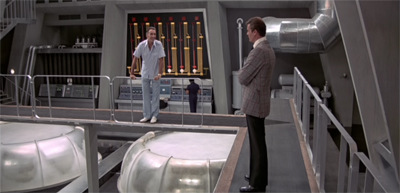




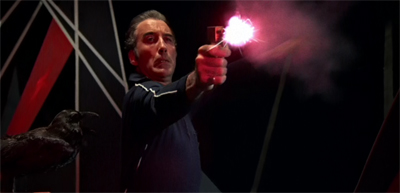
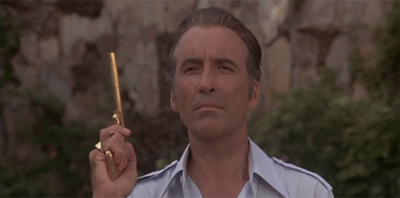
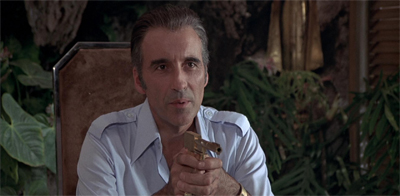





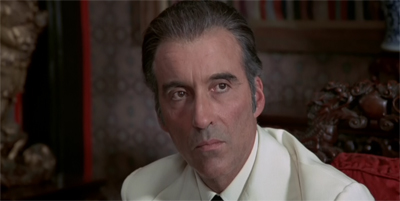



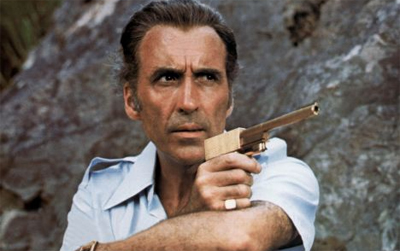
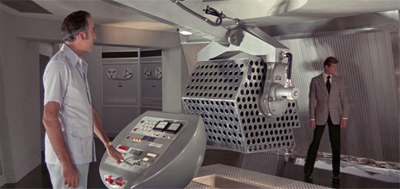
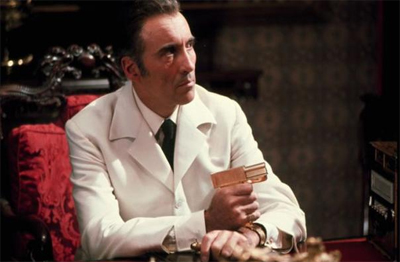





Reblogged this on "You Jivin' Me, Turkey?" and commented:
“The Man With The Golden Gun” May Not Be My Favorite Bond Epic…
…But Christopher Lee’s “Francisco Scaramanga” Is Totally MY Favorite Bond Baddie!!!
Nice To See He’s Getting Some Sweet-Sweet-Lovin’!!!
Awesome Work Here, Fo SHO!
=D
-BRAD
Thanks Brad, glad you liked it!
Loved This Piece, Dude!
Loved It Loved It!!!
-B.
He’s great, isn’t he?
Reblogged this on Bluxome Street Post.
Lee and Moore first worked together as stage door johnnies in 1949’s TROTTIE TRUE
Nice. I did not know this. Thanks!
One of the best Bond villains with one of the weakest deaths.